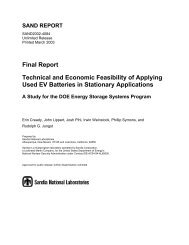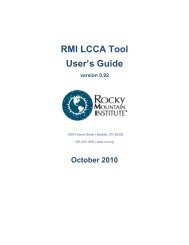Fleet Electrification Roadmap
Fleet Electrification Roadmap
Fleet Electrification Roadmap
- No tags were found...
You also want an ePaper? Increase the reach of your titles
YUMPU automatically turns print PDFs into web optimized ePapers that Google loves.
74 part two: fleet challengesfleet electrification roadmap 75ABSTRACTWhile commercial and government fleets do possess anumber of important advantages that could facilitatetheir adoption of grid-enabled vehicles, they will alsoface challenges. Some of the fundamental cost andtechnology issues affecting personal-use consumerswill also be problematic for fleets. Today’s high lithiumionbattery costs will limit the attractiveness of GEVs insome instances. High costs for drivetrain components andthe need to invest in infrastructure will also impact theeconomics of GEVs.Vehicle leasing and fleet owners’ access to capital mayallow them to address these issues more easily than thetypical consumer, but GEVs will also require many fleetowners to be flexible and adapt to new business andacquisition practices. In addition, vehicle electrificationmay present a set of unique challenges for fleet operators,requiring a combination of careful planning and targetedpublic policy support.CHAPTER 2.1OverviewNumerous advantages of commercial and government fleet owners should help tofacilitate their adoption of grid-enabled vehicles. However, a number of challengeswill require public policy support in the near term.The original <strong>Electrification</strong> <strong>Roadmap</strong> identified four keychallenges that could impact adoption of plug-in hybridand electric vehicles among consumers in the personaluseautomotive market. These challenges included:1. The high cost of the vehicles themselves,driven largely by the batteries;2. the lack of available public charginginfrastructure;3. the need to enable successful vehicleutilityinterface; and4. a lack of mainstream consumer acceptanceof grid-enabled vehicles.As outlined in Part One of the <strong>Fleet</strong> <strong>Electrification</strong><strong>Roadmap</strong>, commercial and government fleet operatorsshould be well-prepared to address a number ofthese challenges. By matching the proper vehicle, batteryand drivetrain technology to required payloadrequirements, drive cycles, and usage profiles, fleetoperators can minimize upfront investment costs.Total investment in public and private charging infrastructurecan also be efficient and optimized. Perhapsmost importantly, grid-enabled vehicles could appealto a significant number of fleet operators more quicklythan they will appeal to mainstream consumers in thepersonal-use auto market. In that case, fleet operatorswould account for significant early demand volumes inthe development of the large-format battery industryin addition to catalyzing the ramp-up of electric drivetraincomponent supply chains.Nonetheless, the basic structure of challengesinhibiting mainstream consumer adoption can be usedto identify potential challenges and problem areas thatmay need to be addressed in order to help facilitate commercialand government fleet adoption of GEVs. The highcosts of battery and vehicle drivetrain components are anobvious example. High costs for lithium-ion batteries willimpact the economics of GEVs for fleets just as they willfor consumers. In fact, because many of the electric drivetrainsupply chains for medium- and heavy-duty trucksare particularly immature today, the first GEVs comingto market in these segments carry a price premium wellabove what would be expected based on a “should cost”analysis of analogous light-duty components.While the need for public charging infrastructure isless of an issue for many fleets, it could be important forsome applications. In particular, fleets that tend to havehigh daily miles traveled and high utilization rates—suchas taxis or long-haul delivery vehicles—could be highlydependent on public charging infrastructure. In fact, theextremely high utilization rates of taxis could necessitateaccess to fast charging or battery swapping as a means tomaintain high levels of operation. And while this may beappealing from a technical standpoint, the cost of suchsystems could be an issue. Moreover, integrating thecharging of fleet vehicle batteries with the electric powersector could actually be more—not less—challenging thanintegrating typical consumer vehicles in some cases.In addition to these challenges, commercial and governmentfleet operators will have to manage a set of fiscal,budgetary, and operational challenges that in some casesare analogous to typical consumers but can also be quitedifferent. Federal government agencies, for example, areultimately highly constrained in managing their budgets,and the focus tends to be on near-term cost reductionsas opposed to long-term savings (though emissions andfuel-efficiency mandates are increasingly altering thisdynamic). In the private sector, fleet operators do tend tofocus on lifecycle vehicle costs, though they also carefullymanage the tradeoffs between investing capital in newvehicles versus other productive uses.
















